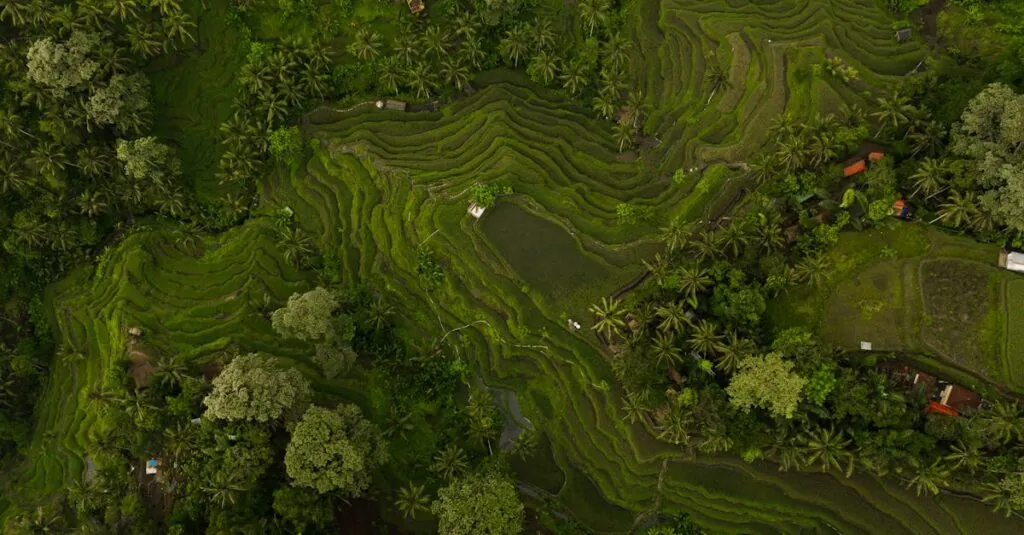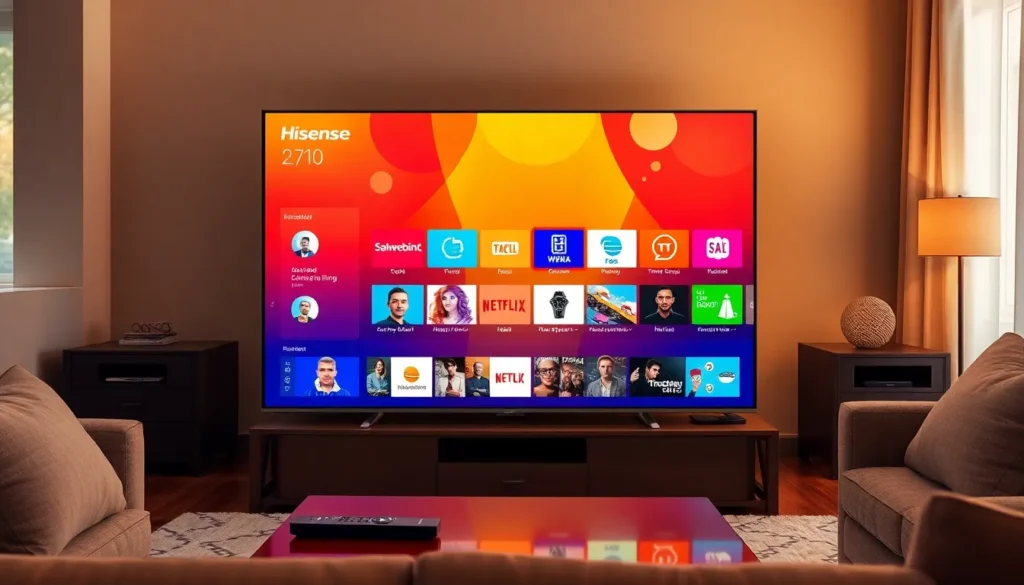In a world where everyone’s trying to save the planet while sipping their organic lattes, remote sensing steps in like a superhero with a high-tech cape. This innovative technology uses satellites and drones to gather data about our Earth, making it easier to monitor everything from deforestation to urban sprawl. Imagine having a bird’s-eye view of environmental changes without needing to climb a tree or, heaven forbid, get muddy!
Table of Contents
ToggleOverview of Remote Sensing for Sustainability
Remote sensing serves as a critical tool in achieving sustainability goals. Utilizing satellites and unmanned aerial vehicles, it gathers extensive data regarding terrestrial and atmospheric conditions. This data provides insights into land usage, resource management, and environmental monitoring.
Monitoring deforestation is one key application of remote sensing. Satellite imagery allows researchers to track forest loss over time, quantifying changes in biodiversity. Urban expansion also comes under scrutiny, with remote sensing revealing patterns of growth and their impacts on local ecosystems.
Data analysis using remote sensing techniques contributes to effective decision-making. Geographic Information Systems (GIS) integrate remote sensing data for visualization and management, enabling stakeholders to prioritize areas needing intervention. Moreover, assessing water resources becomes simpler through remote sensing, as it measures changes in water bodies and identifies potential drought regions.
Remote sensing enhances agricultural practices through precision farming. This approach employs aerial imagery to assess crop health and soil conditions, optimizing input use such as water, fertilizers, and pesticides. Sustainable urban planning benefits, too, as planners utilize spatial data to design smarter cities with green spaces and efficient transportation systems.
Engaging multiple sectors, remote sensing fosters collaboration among governments, NGOs, and local communities. Sharing data with various stakeholders encourages informed decisions, enhancing resource management. Overall, remote sensing stands out as an instrumental method for promoting sustainability initiatives and attaining environmental goals.
Key Technologies in Remote Sensing
Remote sensing relies on various technologies to gather critical environmental data. Two primary methods include satellite imagery and drone technology.
Satellite Imagery
Satellite imagery captures vast areas of the Earth’s surface, offering a comprehensive overview of landscapes. Satellites orbiting the planet provide continuous data, enabling the monitoring of environmental changes over time. One significant advantage lies in the ability to assess large regions, making it easier to identify deforestation and urban expansion. Data obtained from satellites support effective analysis in Geographic Information Systems (GIS), facilitating informed decision-making for sustainability efforts. High-resolution images from satellites provide insights into land use and vegetation cover, essential for evaluating impacts on ecosystems.
Drone Technology
Drone technology significantly enhances remote sensing capabilities through its ability to collect high-resolution data over specific areas. Drones operate at lower altitudes, capturing detailed images that reveal more precise information than satellite data. Flexibility in flight paths allows for targeted data collection, essential for monitoring changes in agriculture and urban areas. Real-time data acquisition supports immediate assessments of environmental conditions, aiding quick interventions. Furthermore, drones can access hard-to-reach locations, broadening the scope of environmental monitoring. This innovative technology combines efficiency with detail, proving invaluable for sustainability initiatives.
Applications of Remote Sensing for Sustainability
Remote sensing plays a crucial role in advancing sustainability through various applications. Its ability to collect data remotely enables efficient monitoring of critical sectors.
Agriculture Monitoring
Precision agriculture benefits significantly from remote sensing technologies. Farmers utilize satellite imagery to assess crop health and soil moisture levels. This data supports timely irrigation and fertilization adjustments, enhancing yield quality. Drones, equipped with multispectral sensors, capture high-resolution images of fields, identifying areas needing attention. Integrated data analysis fosters informed decision-making, optimizing resource usage for sustainable farming practices.
Urban Planning
Smart urban planning increasingly relies on remote sensing data. Planners analyze satellite images to understand urban expansion and land use changes over time. This insight helps identify trends in population density and infrastructure needs. High-resolution drone imagery offers detailed views of urban environments, supporting efficient resource allocation. Integrating this data into Geographic Information Systems (GIS) facilitates collaborative planning, promoting sustainable city development.
Natural Resource Management
Natural resource management gains precision through remote sensing applications. Satellite data provides insight into forest cover changes, enabling better tracking of deforestation rates. It aids in monitoring water bodies, assessing quality and availability. With real-time data from drones, stakeholders can respond quickly to environmental changes. Effective analysis of this information guides sustainable practices in forestry and water management, ensuring resources remain viable for future generations.
Benefits of Utilizing Remote Sensing
Remote sensing offers numerous advantages for sustainability efforts. These benefits enhance the ability to monitor and manage natural resources effectively.
Increased Efficiency
Enhanced efficiency becomes evident through rapid data collection across vast areas. Remote sensing technology captures high-resolution images and gathers vital insights quickly. Monitoring changes in land use or environmental conditions occurs almost in real time. Stakeholders can act swiftly on trends, reducing the time spent on surveys and fieldwork. Furthermore, automated analysis tools streamline data processing, ensuring accurate assessments. Effective resource management results from integrating this technology into decision-making processes.
Cost-Effectiveness
Cost efficiency significantly improves through the employment of remote sensing methods. Traditional data collection methods, such as field surveys, often incur high labor costs and extended project timelines. Remote sensing reduces these expenses by minimizing the need for extensive groundwork. Satellite imagery and drone technology offer scalable solutions, allowing for both large and small area assessments without prohibitive costs. As a result, organizations can allocate resources more strategically, optimizing budget adherences while gaining critical data for sustainability initiatives. This combination fuels long-term sustainable practices and improved financial planning.
Challenges and Limitations
Remote sensing technologies face various challenges and limitations that can affect their effectiveness in promoting sustainability. Understanding these hurdles is crucial for maximizing their potential.
Data Quality Issues
Data quality represents a significant challenge in remote sensing. Variations in satellite sensor specifications can lead to inconsistencies in image resolution and accuracy. Factors such as atmospheric conditions often distort the data captured, impacting the reliability of analyses. Calibration processes further complicate data interpretation. Without proper calibration, critical insights regarding environmental changes may become flawed or misleading. Addressing these quality issues is essential for ensuring effective monitoring and decision-making.
Accessibility and Training
Accessibility presents another barrier for organizations utilizing remote sensing data. Many users lack access to sophisticated remote sensing technology. Moreover, the complexity of the data often requires specialized knowledge for effective interpretation. Users without adequate training may find it challenging to analyze imagery and derive actionable insights. Improved training programs and accessible tools can help bridge this gap, enabling broader utilization of remote sensing for sustainability initiatives. Encouraging collaborations between technology providers and local stakeholders can enhance skills and access.
Future Trends in Remote Sensing for Sustainability
Emerging technologies continue to shape remote sensing’s role in sustainability. Artificial intelligence (AI) enhances data analysis, allowing for faster interpretations of complex environmental patterns. As these technologies evolve, they improve accuracy and efficiency in monitoring deforestation and urbanization.
Satellite constellations become increasingly sophisticated, providing higher-resolution imagery and more frequent updates. Improved satellite data facilitates ongoing environmental assessments, ensuring timely interventions. Drones also progress with advanced sensors that capture critical data in real time, pushing the boundaries of localized monitoring.
Integration of remote sensing with blockchain technology offers enhanced data security and transparency. Accessible data enters decentralized systems, enabling stakeholders to collaborate and share insights more effectively. This opens new avenues for cooperative sustainability efforts.
Public participation in data collection gains traction through mobile applications. Citizens engage with remote sensing initiatives, contributing localized observations and enriching datasets with diverse input. This crowdsourced information fosters community involvement and enhances project relevance.
The shift toward open-source platforms promotes collaboration and innovation within the remote sensing community. Researchers and developers share techniques and findings, fueling advancements and generating solutions that address sustainability challenges. This collective knowledge drives further adoption and application of remote sensing technologies.
Finally, partnerships between governmental agencies, private sectors, and NGOs become pivotal in advancing remote sensing initiatives. By pooling resources and expertise, stakeholders can tackle pressing environmental issues collaboratively. With shared goals, such partnerships increase the impact of remote sensing on sustainability outcomes.
Conclusion
Remote sensing stands as a pivotal technology in the pursuit of sustainability. By harnessing satellite imagery and drone capabilities, it offers unparalleled insights into environmental changes and resource management. This innovative approach not only enhances agricultural practices and urban planning but also empowers stakeholders to make informed decisions for a sustainable future.
As advancements in technology continue to evolve, the integration of artificial intelligence and blockchain will further refine data analysis and security. The collaborative efforts between various sectors will be essential in overcoming existing challenges and maximizing the potential of remote sensing. With a commitment to innovation and cooperation, the path toward a more sustainable world becomes clearer and more attainable.













